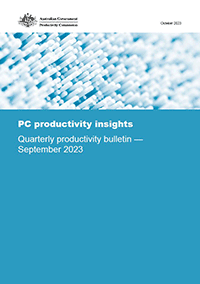Quarterly productivity bulletin – September 2023
PC productivity insights
Released 10 / 10 / 2023
This Bulletin unpacks the Australian Bureau of Statistics (ABS) September 2023 quarterly productivity statistics release and examines trends and new developments underlying Australia’s productivity performance.
The key message is that the fall in labour productivity in the June 2023 quarter was a result of a historically large increase in hours worked, which outpaced output growth.

Media release
Productivity goes backwards as Australians ‘running to stand still’
Productivity decreased by 2% in the June 2023 quarter, as record-high growth in hours worked outpaced output growth, according to the Productivity Commission’s latest Productivity Bulletin.
“Our unemployment rate remains low. Australians worked more in the June quarter as cost-of-living pressures continue to bite. But even though hours worked rose, the rise in output was more modest, and that shows up as a reduction in labour productivity,” Acting Chair Alex Robson said.
The report finds that while output was up 0.4%, hours worked for the whole economy and the market sector increased by 2.4% and 2.2% respectively – the largest quarterly increase on record outside the COVID-19 pandemic.
“Productivity growth is about working smarter, not working longer or working harder. Negative productivity growth means that on average, Australians worked more hours just to produce and buy the same amount of goods and services. In other words, Australians have been running to stand still.”
The report suggests that while demand for labour may taper off as interest rates rise and the economy slows, we can’t rely on short term fluctuations in hours worked as a source of long-term productivity growth.
“Our productivity challenge has been urgent for many years. We will only see sustainable, long-term productivity growth if we increase investment and innovation,” Dr Robson said.
The research finds that 15 out of 19 industries experienced a decline in labour productivity over the 2023 June quarter.
The arts and recreation services industry saw the largest decline in productivity (-7.6%), as hours worked increased by 9.3% while output rose only 0.9%.
However, three industries drove about 46% of the overall labour productivity decline: mining; electricity, gas, water and waste services; and information, media and telecommunications.
The mining industry alone made up around one-third of the total labour productivity decline, as hours worked increased while output significantly declined. The decline in mining output was mainly driven by a decrease in iron ore mining and oil and gas extraction, as adverse weather and planned maintenance reduced production capacity.
Media requests
Media team – 02 6240 3330 / media@pc.gov.au
Key points
- Labour productivity decreased by 2% for the whole economy in the June 2023 quarter, which resulted in an expected 3.2% fall in productivity from 2021-22 to 2022-23.
- The output of twelve industries grew but did not keep up with the growth in hours worked.
- Only four industries saw productivity growth in the June quarter.
-
Australians worked more hours than ever before in the June quarter. The increase in hours worked could be due to:
- more hours worked by people already in employment, possibly to compensate for the significant recent decline in inflation-adjusted household net wealth
- a historically tight labour market which was associated with record high participation rates, with more people entering the workforce and working longer
- an unwinding of the COVID-19 pandemic restrictions in 2021-22, resulting in workers returning to work.
Media requests
Media team – 02 6240 3330 / media@pc.gov.au
Contents
Bulletin – September 2023
- Preliminaries: Cover, Copyright and publication detail and Contents
- Key points
- Australians worked longer, but productivity fell
- More productive industries reduced hours worked
- Abbreviations
- References
Appendix: Supporting data
- Preliminaries: Cover and Copyright and publication detail
- A primer on productivity
- Detailed productivity statistics
- Productivity data revisions
We value your comments about this publication and encourage you to provide feedback.